 Given the Spressa’s impressive performance and the universal identification of its manufacturer’s name, many users’ first CD recorder will undoubtedly be a Sony.
Given the Spressa’s impressive performance and the universal identification of its manufacturer’s name, many users’ first CD recorder will undoubtedly be a Sony.
The New Spressa 920: It’s a Sony
Hugh Bennett
CD-ROM Professional, October 1995
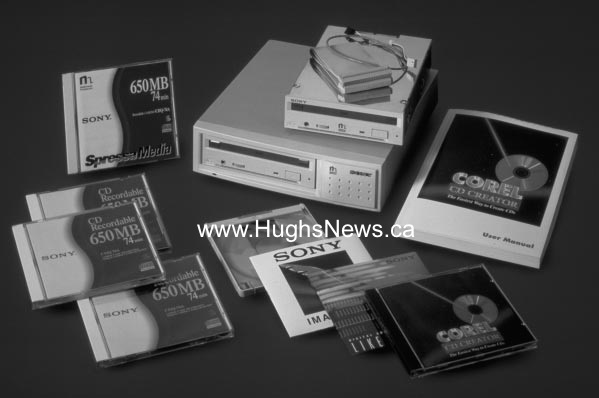 Few corporate names are as identifiable as Sony. In the early days of the O.J. Simpson trial, even Judge Ito’s monitor carried the Sony name, emblazoned in black in full view of the trial’s legions of rapt TV viewers. Later whited out and more discreetly located behind the witness, this positioning and opportune exposure speaks volumes for the competence of those who market Sony merchandise. Electronics experts will probably tell you that the current market features better products than those Sony offers, but Sony is the brand most people trust for quality.
Few corporate names are as identifiable as Sony. In the early days of the O.J. Simpson trial, even Judge Ito’s monitor carried the Sony name, emblazoned in black in full view of the trial’s legions of rapt TV viewers. Later whited out and more discreetly located behind the witness, this positioning and opportune exposure speaks volumes for the competence of those who market Sony merchandise. Electronics experts will probably tell you that the current market features better products than those Sony offers, but Sony is the brand most people trust for quality.
Sony’s Spressa line of drives is the company’s first branded CD-Recordable offering to be sold through reseller and retail channels. Available in both internal Spressa 920 and external Spressa 9211 configurations, the systems are targeted for software development, archiving, and backup applications in both corporate and small office environments. Given the Spressa’s impressive performance and the universal identification of its manufacturer’s name, many users’ first CD recorder will undoubtedly be a Sony.
The Spressa 920 is a true SCSI-2 double speed CD recorder and CD-ROM drive with a caddy loading 5.25″ design and enough features to satisfy the needs of most users. Using Sony’s new CDU-920S mechanism, it writes CD-ROM modes 1 and 2, CD-ROM XA mode 2 forms 1 and 2, CD-DA, mixed-mode, CD-i, CD-i Ready, and CD Bridge (Photo CD, Video CD) discs. Also included is Kodak bar code recognition, compatibility with 12cm and 8cm disc sizes, and Disc-At-Once, Track-At-Once, multisession, and packet-writing modes.
PACKAGED DEAL
The $1995 Spressa 920 mounts in any standard PC-compatible 5.25″ drive bay and is as easy to install as a normal CD-ROM drive. It comes with three blank 74-minute discs, caddy, internal SCSI cable, an audio cable for connecting the drive to a sound card (for playing audio CDs),and Corel Corporation’s entry-level CD Creator software for Windows. CD Creator is an easy-to-use application that permits the writing of ISO 9660, CA-DA and mixed-mode discs. To complete the installation, users must add an appropriate bus mastering SCSI host adapter card like an Adaptec 1542cf. The package includes, as a bonus, a one-time offer coupon from Digital Audio Disc Corporation (DADC) for CD-ROM replication services which, for $1000, entitles owners up to five hours of premastering and mastering, plus 100 discs with 2-color printing, and jewel cases–all within a five-day turn around time.
The $2299 Spressa 9211 package contains an external recorder, Corel’s CD Creator software for both Windows and Macintosh, ten blank 74-minute discs, caddy, power cord, SCSI cable and terminator, audio cable, and the special offer from DADC. Both the 920 and 9211 carry one-year warranties with Sony providing technical support; however, software questions must be referred directly to Corel.
SOMETHING IN COMMON
The Spressa 920 represents a significant advance in CD recorder evolution. It is the first writer to incorporate components from an existing CD-ROM drive, in this case Sony’s well-proven and popular CDU-561 SCSI double speed unit. Not only does this mean that Sony can get new systems quickly to market (as they need not design and manufacture writers from scratch), but it also allows the company to benefit from reduced per unit costs and the capacity to fill large unit orders in a growing market.
Given these economies of scale, companies like Sony and Philips who manufacture standard CD-ROM drives have a formidable long term competitive edge in the high-volume marketplace over competitors such as Yamaha, JVC, and Ricoh, who lack existing CD-ROM drive production capabilities. It will be interesting to see if Sony’s significant manufacturing advantages and powerful OEM (Original Equipment Manufacturer) position will force others into abandoning their own mechanisms in favor of rebundling or offering higher-end recorders that are not in direct competition with Sony.
SYSTEM REQUIREMENTS
Like all other CD recorders, the 920 demands a continuous stream of data for successful disc creation. Double speed recording requires a sustained transfer rate of 307.2KB/sec for Mode 1 and 352.8KB/sec for Mode 2 and audio sectors while single speed calls for 153.6KB/sec for Mode 1 and 176.4KB/sec for Mode 2 and audio sectors.
Given the demands of double speed recording and the 920’s 1MB buffer size, realistic system requirements for Macintosh users are at least a 68040 processor, 8MB RAM, System 7 or later. A minimum PC-compatible system consists of at least a 486DX 33MHz, 8MB RAM, MS-DOS 5.0 or later, Windows 3.1 or later, and SCSI bus mastering host adapter. Systems should also include a 1GB or larger hard disk drive with an access time below 12ms, a sustained data transfer rate of at least 1.2MB/sec, and no thermal recalibration problems.
HOW WELL DOES THE SPRESSA 920 WORK?
In order to evaluate the full capabilities and overall stability of the recorder, testing was conducted on a Macintosh Centris 660AV with 8MB RAM and a 486DX/266MHz PC-compatible with 8MB RAM and an Adaptec 1542cf SCSI host controller, using a wide variety of software, as follows:
* QuickTOPiX Mac, Optical Media International
* Toast CD-ROM Pro Mac, Astarte
* CD-IT!ALL Mac, OptImage
* CD Creator Windows, Corel
* GEAR Windows, Elektroson
* CD Record Windows, Dataware
* Spira Windows, Moniker
Both a Spressa 920 and a Smart & Friendly CD-R 1002 were used to make sure that there were no observable differences between the performance of a Sony Spressa and its OEM CDU-920S counterpart. Tests took place under different conditions such as recording on-the-fly or from physical images, 1X and 2X recording speeds, and writing different disc types. Generally speaking, the Spressa and CD-R 1002 perform identically with solid, predictable, and reliable results in all situations.
The Spressa follows the industry trend for 2X recorders and comes equipped with a 1MB buffer. As a result, if the flow of data to the unit is interrupted while writing mode 1 sectors at double speed, the recorder exhausts its buffer within approximately 3.3 seconds. When writing mode 2 or audio sectors at double speed, the safety margin is reduced to 2.9 seconds before generating a buffer underrun. This provides adequate protection for most properly configured systems; if recording is simulated before discs are actually written, users should experience few problems with the Spressa’s write functions.
However, a 1MB buffer is not fool-proof and can easily encounter a buffer-underrun at double speed. During testing, it became apparent that inadequate or improperly configured systems, a series of small files sent on-the-fly to the recorder, a fragmented hard disk drive, or thermal hard disk drive recalibration can still bring the writing process to a grinding halt. Most of these problems can be avoided by producing a physical image or writing multitrack data (depending on the software’s capabilities) or reducing the recorder’s speed to 1X (which gives the Recorder twice as much time to empty the buffer), but these work-arounds partially defeat the purpose of having a double
speed device.
Considering that CD-Recordable is entering the mainstream market and the Spressa is aimed at a broad spectrum of new users, Sony would have been wise to incorporate a larger 2MB buffer in the system. As it stands, resellers and users will just have to be appropriately cautioned.
PARTIAL RECOVERY FROM DATA FLOW FAILINGS
Even with a carefully configured system, there can still be interruptions in the data flowing between host computer and recorder that result in buffer underruns. Normally, that will render a disc unusable, but the Spressa’s unique “track recovery” feature enables the unit to recover the data on the track where an error occurs and reclaim the rest of the disc for writing. (Incat Systems’ Easy-CD Pro for Windows is currently the only software that supports this feature.)In theory, if the Spressa encounters a write error, the CD-Recordable software implements the unit’s automatic “recover track” firmware routine which salvages all the data written up to the point where the error took place and closes the track. Users are then free to access the resurrected information and write to the disc again. Depending upon how the software implements the function–during or after a write–it is even possible to damage discs on non-Sony recorders, insert them later into a Spressa, and rescue them.
In practice, however, track recovery effectively allows users to write additional material to discs that would otherwise end up in the garbage, but does not adequately reclaim data in a damaged track. During this evaluation, discs spoiled on a Spressa 920, Philips CDD521, and Yamaha CDR100 were recovered successfully by the Spressa and written to again without difficulty, but the regenerated tracks always sustained some logical damage. For example, Easy-CD Pro could not load the tracks as references for new sessions, and attempting to access portions of the tracks resulted in “cannot read from drive” errors.
Since the feature is a self-contained function of the Spressa’s firmware, it is likely that these difficulties resulted from shortcomings in its internal programming, rather than from external causes. Unfortunately, few representatives contacted at Sony displayed any knowledge about track recovery, let alone were able to explain and account for these problems.
In its current condition, track recovery raises serious logical integrity concerns and evokes other worries, like the dire consequences of mistakenly sending recovered CD-ROMs off for replication. However, if all you want to do is reclaim the space on the rest of an injured disc and not access the problem area, the feature is quite valuable and should save a lot of discs from being junked and ease some frustrations experienced by the legions of new CD-Recordable users.
NO GUARANTEES AT SINGLE SPEED
Although no single speed recording problems were experienced during the course of this evaluation, and several other users contacted had similarly flawless results, Sony does not currently sanction single speed recording. Apparently, a few beta test sites reported some problems writing discs at single speed. Sony officially sells the Spressa as a double speed recorder and does not guarantee that all manufacturers of discs written under all environmental conditions at single speed will be recorded properly. However, company representatives indicated that the firmware is already being modified to correct any of these outstanding issues.
NO CD PLUS
Depending upon your needs, one limitation to keep in mind is that the present firmware will not allow users to write Enhanced CDs (audio tracks in the first session and data tracks in the second session); since the CD recorder insists that if the first session on a disc is closed as CD-DA, the entire disc must be finalized as a single session CD-DA disc.
According to Sony representatives, the restriction is imposed because the formal specification for CD Plus had not been established at the product’s release. Now that the CD Plus specification has been finalized, however, users should expect that–as the company promised–Sony will upgrade to this capability, too. In the mean time, the artificial limitation makes no sense. Many users are currently producing such discs and have a legitimate need for the capability.
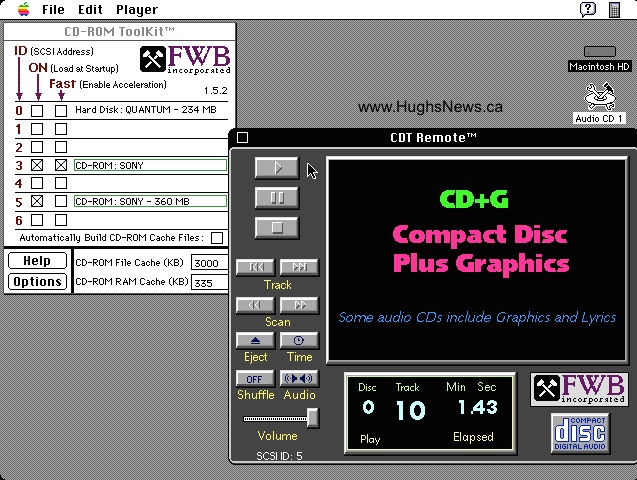 TRUE DOUBLE SPEED CD-ROM DRIVE
TRUE DOUBLE SPEED CD-ROM DRIVE
The Spressa is part of the next generation of multifunction units operating both as a true double speed CD-ROM drive and writer. Traditionally, CD recorders have exhibited hideous playback performance. Sustained transfer rates have improved over the past year on other units, but average access times have been far too high to use the devices for anything but checking basic disc layout.
The Spressa is a solid performing double speed CD-ROM drive and is suitable for everyday use. It features a 300KB/sec sustained data transfer rate, an average access time of 300ms, and utilizes all of the 1MB buffer for playback.
A particularly attractive feature that should improve compatibility is that the 920 does not require custom MS-DOS device software and works well with drivers like Corel’s CUNI_ASP.SYS (included with CD Creator) and Adaptec’s ASPICD.SYS (included with Adaptec EZSCSI). For Macintosh users, driver choices range from the basic data support offered by Astarte Toast’s CD Reader extension to the more comprehensive solutions offered by FWB’s CD-ROM Toolkit and OMI’s WarpVeloCD. CD-ROM Toolkit provides the most capabilities with Power Macintosh native code, driver-based caching, digital audio extraction through QuickTime, and compatibility with HFS, ISO 9660, Hybrid, Photo CD, CD-DA, Enhanced CD, CD+G, and ProDOS discs.
In addition to being able to play standard audio compact discs, the unit also offers double speed digital audio extraction capabilities so CD-DA tracks can be read directly from a disc and recorded to the hard drive as 16-bit, 44.1KHz audio files. Many people find this a useful feature for applications like legitimate disc duplication or incorporation of audio into multimedia projects.
MODES, SUBCODES, AND FIRMWARE
As a fully functional CD recorder, the Spressa 920 records in a number of modes, including state of the art Disc-At-Once, which boasts the convenience of allowing an entire CD-ROM to be written at a single sitting. The recorder also supports limited subcode encoding and features software-upgradable ROMs known as “flash firmware.”
WRITING MODES
The Spressa currently offers Track-At-Once (TAO), multisession, and Disc-At-Once (DAO) recording modes, as well as support for both Orange Book fixed and variable packet writing.
TAO and multisession capabilities allow users to add incrementally to a CD-R disc by recording at later times while DAO is a professional-level feature that writes an entire CD-ROM in one sitting. Since DAO writes CD-ROM in one continuous and uninterrupted operation, final discs do not use the run-in, run-out, and link blocks between tracks required by TAO and are, therefore, more desirable for audio work and as premasters for replication. DAO also allows variable pause lengths between audio tracks (from zero to two seconds with the Spressa), in contrast with the two-second gap required by TAO recording.
Many observers feel that packet writing is critically important to CD-Recordable’s adoption for the in-house storage and archiving market, since it promises to make the process of writing data to CD recorders more like saving information to hard disk drives. Rather than recording large sets of data at a single sitting like TAO, packet writing records as little as one file at a time. Less disc space is wasted for each write as the method eliminates the multimegabyte overhead of full table of contents information, lead-in/lead-out, and intersession gap required by conventional multisession. In addition, with packet writing, the possibility of buffer-underrun is virtually eliminated.
However, successfully implementing a packet writing scheme remains elusive for Sony and others because of a number of unsettled technical questions. A major issue is the current inability of CD recorders to write to a disc more than 99 separate times due to a limitation in the way CD recorders calibrate laser energy. As well, a new or modified version of the ISO 9660 file system is required to handle the differences introduced by packet writing. Because an international standard covering packet writing is still forthcoming, current ambiguity means that most software companies do not yet take advantage of the 920’s packet writing capabilities. Today, it remains unclear if Sony will have to further upgrade the unit’s firmware to support whatever standard is settled upon.
SUBCODE SUPPORT
The Spressa 920 recorder offers partial PQ subcode encoding, so information like copy-prohibit and preemphasis flags can be saved to disc in the Q subcode channel. However, those doing professional-level audio work should note that the unit reads, but does not write Uniform Product Code/European Article Number (UPC/EAN) and International Standard Recording Code (ISRC) media catalog numbers, and only generates one audio index point. Sony also chose not to implement R-W subchannel encoding since it is only required for seldom-used formats like CD+G (Graphics) and CD+M (MIDI).
FLASH FIRMWARE? YES AND NO
Like most new CD recorders, the Spressa features software-upgradable ROMs or “flash firmware.” Whenever there is a feature addition, enhancement, or bug-fix to the basic intelligence of the recorder, the upgrade is performed by simply downloading new software from the host computer, rather than physically swapping chips. Flash firmware, therefore, theoretically makes life easier for both manufacturer and user.
With flash firmware, manufacturers need not warehouse components which eventually become useless; instead they can inexpensively upgrade existing stock and already installed systems. Since new recorders always have bugs, it is attractive for buyers to know that most problems can be resolved quickly and inexpensively without shipping their recorder away for upgrading. (Note: Sony has already quickly jumped from the initial release 1.1b version to 1.1c and 1.1d.) At least, that is the theory.
However, unlike companies like Plasmon, Pinnacle Micro, and JVC, who make firmware updates available to their OEM customers, developers, resellers, and end-users, Sony keeps firmware in-house. Therefore, recorders must be returned to Sony service depots for upgrading. Company representatives explain their policy in terms of safeguarding the confidentiality of their microcode and protecting customers from unintentionally disabling their unit. From the buyer’s perspective, however, there is no real advantage in having flash firmware over hard-programmed chips in the Spressa if the net result is the same: the unit must be returned for depot service to have an upgrade. When buying any recorder, it is important to remember that just because a company says their unit has flash firmware does not automatically mean that the feature is of any real benefit to the purchaser.
SPRESSA 920 IS HIGH IN FIDELITY
Given the physical complexities of writing CD-Recordable discs, it is wise to be skeptical any time a lower-priced recorder comes on the market. The more important question is whether manufacturers achieve price reductions by means of genuine technological advances, superior processes and higher sales volumes, or whether they take the quick way out and simply cheapen the product. In the case of Sony, test results indicate that they have taken the high road.
Most importantly, for a disc to have a high probability of being readable by any CD-ROM drive and have acceptable data life, a recorder must write the disc so that it conforms to the physical specifications defined by the Red and Orange Books. To verify the Spressa’s compliance, a number of completed 74-minute Verbatim, TDK, MTC, and Sony discs were written and independently analyzed with CD CATS SA3 Advanced and Philips CDP920JT testing equipment for the range of standard criteria like jitter and deviation, reflectivity, push-pull, symmetry, E32 uncorrectable errors and so on. Results from these limited tests indicate that the Spressa functions well on a wide range of media types and discs written on the recorder suffer from no obvious problems.
To ensure logical integrity as well, analysis of a number of discs was performed by Enterprise Corporation International (ECI) using their Disc Detective 2.9 software. ECI is well-regarded for the technical support it provides for CD-ROM drive manufacturers and the test software it develops for the compact disc industry. Using Sanyo CDR-254SH (4X SCSI), Sony CSD-760S (4X SCSI), and Chinon CSD-525S(2X SCSI) CD-ROM drives, ECI examined discs to verify that each sector of each disc was readable and contained no uncorrectable errors; their tests also measured skew and post-gap and performed a bit-for-bit data comparison between the source image and the completed CD-ROMs to ensure that all of the data was written correctly. As with the physical testing, no issues were found with discs written on the Spressa and Smart & Friendly Units. Solid test results like these, though not the last word, strongly suggest Spressa’s ability to write consistently trouble-free discs.
Sony definitely has a winner on its hands with the Spressa 920 and 9211. There may be slightly less expensive systems available like Pinnacle Micro’s RCD1000, but nothing else in the price range provides the same mix of high dependability and essential features as the Spressa’s. The new Sony CD recorders are competitively priced, write high-quality discs, have stable firmware, offer solid double speed write and read performance, and come with easy-to-use software. In short, the Sony Spressa offers just about everything most people need in a CD recorder.
[Author’s note: I wish to thank the following companies for providing the various products and services used during my review of Sony’s Spressa 920 and Smart & Friendly’s CD-R 1002: Verbatim Corporation, TDK Electronics Corporation, Enterprise Corporation International, Revelation Products Corporation, MTC America/Mitsui Toatsu Chemicals, Inc., OptImage Interactive Services Company, Moniker Inc., Incat Systems Software USA, Dataware Technologies, Inc., FWB, Inc., and Elektroson USA.]
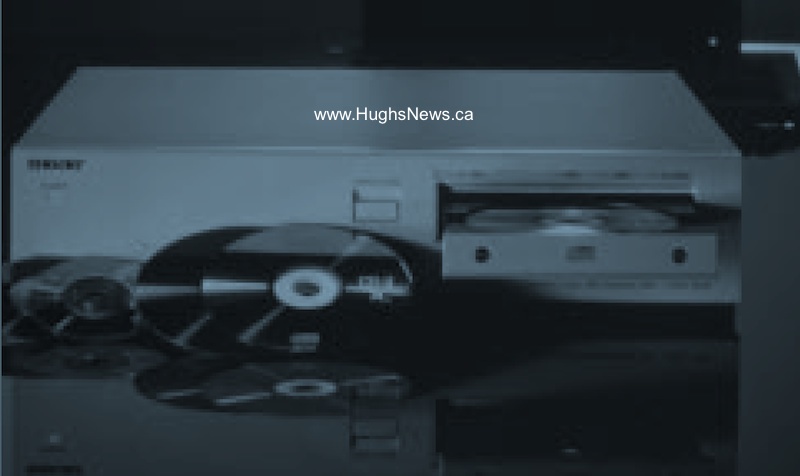 What about the Sony CDW-900E?
What about the Sony CDW-900E?
Although the Spressa is now Sony’s third-generation and flagship CD recorder, the company has no immediate plans to discontinue the venerable CDW-900E. According to Dirk Peters, product manager for CD-Recordable at Sony Component and Computer Products Group, a significant number of those units have been sold worldwide since the 900E’s introduction in 1993. Sony wishes to continue providing systems for owners who already have significant investments in their earlier recorder and who also need its unusual abilities.
Due to its unique daisychaining, R-W subcode, index point, and media catalog number support functions, the 900E is also more appropriate than the 920 for applications such as professional audio, low-run replication, and proprietary Sony PlayStation game system development.
Choices, Choices, Choices
While the Sony Spressa 920 and 9211 recorders are wonderful values, alternatives based on the same solid CDU-920S mechanism are worth considering. Depending upon your needs, other products may offer better prices, longer warranties, and more comprehensive technical support, or come bundled with software with more capabilities or functions better-suited to your intended application.
It is important to realize that capabilities vary widely among software packages, so understanding needs and paying particularly close attention to the software included in the bundle being considered may pay dividends. Be sure that desired and necessary functions are supported.
For example, many software packages only provide generic recording support for the 920 and do not implement DAO recording, disc recovery, or digital audio extraction. Others may offer a feature like digital audio extraction, but are detuned to copy audio tracks at single speed to compensate for the unpredictable performance of end-user systems. If more capabilities are required at a later time, one thing to keep in mind is most software companies provide competitive upgrades to preserve the bulk of your investment.
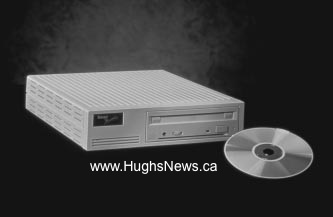 Smart & Friendly
Smart & Friendly
Known for its low-priced CD-R offerings, Smart & Friendly (a division of Van Nuys, California-based High Technology Distributing) was the first company to package professionally and launch the OEM CDU-920S into the mass retail market. Available in four different external configurations, the CD-R 1002 systems are economical and attractive choices for CD-R users on a limited budget.
The $1729 CD-R 1002/C model for PC-compatibles comes with the recorder, an Adaptec 1540cf SCSI host adapter with SCSI cable and terminator, a blank 74-minute disc, Corel CD Creator Windows software, a caddy, a power cord, and a coupon for discounts on the multimedia version of Elektroson’s GEAR for Windows and Enterprise Corporation’s excellent Disc Detective Pro logical disc analysis software. A $2815 CD-R 10002/MAG authoring version is also available; the 10002/MAG substitutes GEAR Windows Multimedia for CD Creator and adds Macromedia Director and Authorware for multimedia development.
The $1999 CD-R 1002/T for Macintosh is also a complete system with recorder, SCSI cable and terminator, Astarte’s Toast CD-ROM Pro software, a blank 74-minute disc, a caddy, and a power cord. For $2599, the CD-R 1002/MAT configuration adds Macromedia Director and Authorware WM software. All CD-R 1002 packages are covered by a one-year warranty with Smart & Friendly providing all of the technical support.
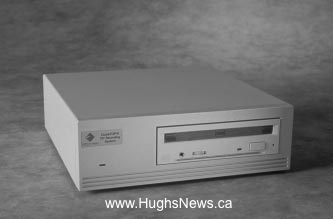 Optical Media International
Optical Media International
Optical Media International’s $1995 OMR120 package bundles the Sony mechanism in an external drive enclosure along with their highly-regarded QuickTOPiX CD-Recordable software for either Windows or Macintosh. OMI includes a SCSI cable and terminator, but PC customers must add an appropriate Adaptec host adapter. The system is covered by a one-year renewable warranty and OMI handles both hardware and software technical support.
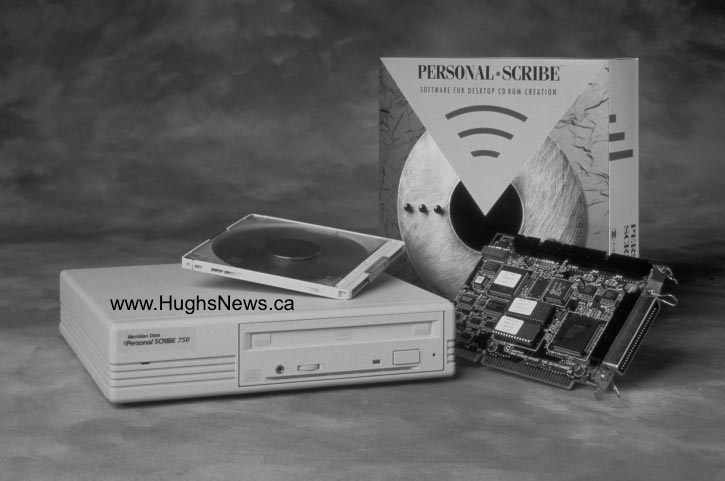 Meridian Data, Inc.
Meridian Data, Inc.
Meridian Data, Inc.’s $2495 Personal SCRIBE 750 package for PC-compatibles is composed of the external recorder with Personal SCRIBE MS-DOS and WinSCRIBE Windows software (an OEM version of Corel’s CD Creator), a SCSI host adapter card, disc caddy, and a blank recordable disc. A $2395 Personal SCRIBE 750i internal configuration is also available and both models carry a one-year warranty with Meridian handling technical support for hardware and software.
FWB
Best known for their line of traditional Macintosh storage products, FWB, Inc. is adding CD-Recording systems to their offerings. The $1899 external HammerCD-R 2X incorporates a Sony mechanism and includes Astarte’s excellent Toast CD-ROM Pro Mac software, one blank recordable disc, CD-ROM Toolkit, a power cord, SCSI cable, active SCSI terminator, caddy, and is covered by a two-year warranty which includes hardware and software technical support.
Sony Electronic Publishing
A long established CD-R developer, distributor, and reseller, the Software Series (SEPC) division of Sony Electronic Publishing sells several bundles making use of the 920S. Their initial offerings include $1675-internal configurations with their entry-level CD Constructor for either Macintosh or Windows, or a $2100 package with the more sophisticated Macintosh Hybrid Formatter software. SEPC also expects to have external configurations available. Systems are covered by a standard one-year warranty and SEPC is responsible for both hardware and software support. – Hugh Bennett
Software and Hardware Supporting the Sony Spressa/CDU-920S
| DOS | Win3.x | Win95 | WinNT | Mac | OS/2 | Sun OS | Solaris | HP | SGI | DG | RS-6000 | DEC | Standalone | NFS | |
| Alea | X | X | |||||||||||||
| Astarte | X | ||||||||||||||
| CeQuadrat | X | X | X | X | |||||||||||
| Corel Corporation | X | X | X | X | |||||||||||
| Creative Digital Research | X | X | X | X | |||||||||||
| Dataware | X | X | X | X | X | X | |||||||||
| Digidesign | X | ||||||||||||||
| Elektroson | X | X | X | X | X | X | X | X | X | X | X | ||||
| Incat Systems | X | X | X | X | |||||||||||
| IMR | X | ||||||||||||||
| Meridian Data | X | X | |||||||||||||
| Moniker | X | X | |||||||||||||
| Optical Media International | X | X | X | X | |||||||||||
| OptImage | X | X | |||||||||||||
| Sony Electronic Publishing | X | X | X | ||||||||||||
| Trace Mountain | X | ||||||||||||||
| Young Minds | X | X | X | X | X | X | X | X |
Product in Brief
Product: Spressa 920, Spressa 9211
Price: $1995; $2299
Contact Information:
Sony Component and Computer Products Group
3300 Zanker Road, San Jose, CA 95134; 800/352-7669
Companies Mentioned in this Article
Alea Systems Inc.
Represented in North America by Revelation Products Corporation
1220 Valley Forge Road
P.O. Box 2225
Valley Forge, PA 19482-2225
800/836-1823; 610/933-5875
Fax 610/933-6190
Astarte GmbH
Weberstrasse
76133 Karlsruhe, Germany
49-(0)721-98 55 40
Fax 49-(0)721-85 38 62
CeQuadrat USA
5 Thomas Melon Circle, Suite 105
San Francisco, CA 94134
800/201-1120; 415/715-5610
Fax 415/715-5610
Corel Corporation
1600 Carling Avenue
Ottawa, Ontario, Canada, K1Z 8R7
800/394-3729; 613/728-3733
Fax 613/761-9176
Creative Digital Research
7291 Coronado Drive
San Jose, CA 95129
408/255-0999
Fax 408/255-1011
Dataware Technologies, Inc.
222 Third Street, Suite 3300
Cambridge, MA 02142
617/621-0820
Fax 617/621-0307
Digidesign Inc.
1360 Willow Road
Menlo Park, CA 94025
415/688-0600
Fax 415/327-0777
Elektroson USA
10 Presidential Boulevard,
Suite 125
Bala Cynwyd, PA 19004
800/606-6116
Fax 610/617-0856
Enterprise Corporation International
1200 Valley West Drive, Suite 120
West Des Moines, Iowa 50266
515/223-1290
Fax 515/223-7749
FWB, Inc.
1555 Adams Drive
Menlo Park, CA 94025
415/325-4FWB
Fax 415/833-4657
IMR
5660 Greenwood Plaza Boulevard
Suite 210
Englewood, CO 80111
303/689-0022
Fax 303-689-0055
Incat Systems Software USA, Inc.
1684 Dell Avenue
Campbell, CA 95008
800/77-INCAT; 408/379-2400
Meridian Data, Inc.
5615 Scotts Valley Drive
Scotts Valley, CA 95066
408/438-3100
408/438-6816
Mitsui Toatsu/MTC America, Inc.
140 E. 45th Street
New York, NY 10017
800/MTC-CDRS; 212/867-6330
Fax 212/867-6315
Moniker, Inc.
108 Whispering Pines Drive
Suite 110
Scotts Valley, CA 95066
408/439-0712
Fax 408/439-0713
Optical Media International
180 Knowles Drive
Los Gatos, CA 95030
800/347-2664; 408/376-3511
Fax 408/376-3519
OptImage Interactive Services Company
1501 50th Street, Suite 100
West Des Moines, IA 50266-5961
800/CDI-5484; 515/225-7000
Fax 515/225-0252
Smart & Friendly
16539 Saticoy Street
Van Nuys, CA 91406
818/944-8001
Fax 818/988-6581
Sony Electronic Publishing Company
Software Series
One Lower Ragsdale Drive, Suite 130
Monterey, CA 93940
408/657-2424
Fax 408/372-7145
TDK Electronics Corporation
12 Harbor Park Drive
Port Washington, NY 11050
800/835-8273
Trace Mountain Products Inc.
1040 East Brokaw Road
San Jose, CA 95131-2393
800/TRACE18
Verbatim Corporation
1200 W.T. Harris Boulevard
Charlotte, NC 28262
800/759-3475; 704/547-6500
Fax 704/547-6609
Young Minds, Inc.
1910 Orange Tree Lane
P.O. Box 6910
Redlands, CA 92375-0910
800/YMI-4YMI; 909/335-1350
Fax 909/798-0488
About the Author
Hugh Bennett, editor-in-chief of Hugh’s News, is president of Forget Me Not Information Systems, a reseller, systems integrator and industry consultant based in London, Ontario, Canada. Hugh is author of The Authoritative Blu-ray Disc (BD) FAQ and The Authoritative HD DVD FAQ, available on Hugh’s News, as well as Understanding Recordable & Rewritable DVD and Understanding CD-R & CD-RW, published by the Optical Storage Technology Association (OSTA).
Copyright © Online Inc. / Hugh Bennett